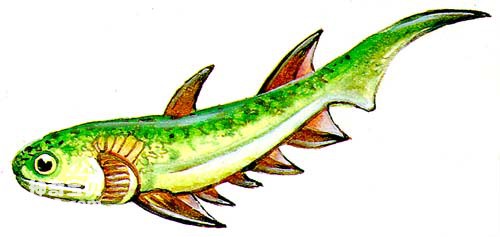As early as the late Silurian period when placoderms just appeared, the most primitive bony fishes, the acanthus, also quietly entered the stage of evolution.
The gate fish of the late Silurian and early Devonian can be regarded as representatives of early stickleback fishes. Their body length is only tens of centimeters, and the body gradually shrinks from front to back, and tilts upward at the end to form a crooked tail; there are two large triangular dorsal fins on the back, each dorsal fin is composed of a cortical membrane, and the front edge of the fin is composed of a strong Supported by bony spines; there is an anal fin of equal size and similar shape in the lower part of the body symmetrical to the dorsal fin; there is a pelvic fin in front of the anal fin; there is a pair of pectoral fins behind the skull; between the pectoral fin and pelvic fin, along both sides of the abdomen there are 5 pairs of smaller fins. These smaller "extra" fins, each with a spine supporting the leading edge, are characteristic of acanthids.
The acanthus fish lived in rivers, lakes and swamps in the middle and late Paleozoic Era, and reached the peak of their evolution in the Early Devonian Period. From then on, they declined, and by the end of the Paleozoic Era, they withdrew from the stage of history.

fish
animal tags:
We created this article in conjunction with AI technology, then made sure it was fact-checked and edited by a Animals Top editor.